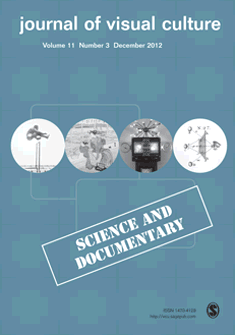
JOURNAL OF VISUAL CULTURE
Scope & Guideline
Unveiling the Impact of Visual Expression
Introduction
Aims and Scopes
- Interdisciplinary Analysis of Visual Culture:
The journal emphasizes the examination of visual culture through various lenses, including art, media, and technology, fostering interdisciplinary dialogue among fields such as sociology, anthropology, and history. - Focus on Marginalized Voices:
A consistent theme in the journal is the representation and empowerment of marginalized communities, exploring how visual culture can serve as a medium for resistance and activism. - Critical Engagement with Technology:
The journal frequently addresses the impact of digital technology on visual culture, including the implications of AI, social media, and virtual reality on perception and representation. - Exploration of Global Perspectives:
Emphasizing a global outlook, the journal covers visual culture from diverse geographical and cultural contexts, particularly focusing on underrepresented narratives and histories. - Historical and Contemporary Contextualization:
The journal provides critical insights into both historical and contemporary visual practices, offering a comprehensive understanding of how past movements influence current visual culture.
Trending and Emerging
- Intersection of Visual Culture and Activism:
Recent publications increasingly explore how visual culture acts as a tool for activism, highlighting works that address social justice, environmental issues, and political movements across various contexts. - Hybrid and Digital Practices:
There is a growing interest in hybrid forms of visual culture that combine traditional media with digital practices, including the use of augmented reality and immersive experiences. - Posthumanism and Non-Human Agency:
Emerging discussions around posthumanism and the agency of non-human entities in visual culture are gaining traction, examining how technology and the environment interact with human experiences. - Visual Culture in the Context of Global Crises:
The journal is increasingly addressing visual culture's role in responding to global crises, such as pandemics, climate change, and political upheaval, emphasizing the relevance of visual narratives in these contexts. - Affective and Sensory Engagement:
There is an emerging focus on affective and sensory experiences in visual culture, exploring how emotions and bodily sensations influence perception and interpretation of visual artifacts.
Declining or Waning
- Traditional Art Criticism:
There has been a noticeable decrease in articles focused solely on traditional art criticism, as the journal increasingly prioritizes discussions that intersect with broader socio-political contexts. - Eurocentric Perspectives:
The journal's content has shifted away from Eurocentric viewpoints, with fewer articles centered on Western art narratives, indicating a broader commitment to global and inclusive perspectives. - Static Representations of Identity:
Themes revolving around static or monolithic representations of identity are less prominent, as the journal increasingly embraces complexity and fluidity in discussions about identity politics. - Conventional Media Forms:
There is a decline in the analysis of conventional media forms such as print and television, with a growing emphasis on new media and digital platforms that challenge traditional boundaries. - Historical Narratives without Contemporary Relevance:
Papers that solely focus on historical narratives without linking to contemporary implications or relevance are becoming less frequent, as the journal aims to maintain a dynamic conversation with current visual culture.
Similar Journals
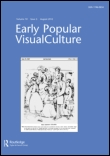
Early Popular Visual Culture
Fostering Critical Dialogue on Visual Arts and SocietyEarly Popular Visual Culture, published by Routledge Journals, Taylor & Francis Ltd, is a pivotal academic journal dedicated to the interdisciplinary study of visual culture from historical and contemporary perspectives. Since its inception in 2009, this journal has carved out a niche within the academic landscape, achieving a notable Q2 ranking in Visual Arts and Performing Arts and Q3 in both Cultural Studies and History categories as of 2023. With an ISSN of 1746-0654 and E-ISSN of 1746-0662, it serves as a vital platform for scholars to disseminate cutting-edge research and critical analysis on visual phenomena that shape popular culture. The journal not only enhances scholarly discourse but also contributes significantly to the understanding of visual practices across different societies. Researchers, professionals, and students will find this journal invaluable for exploring the intricate interactions between visual culture and social contexts, thereby enriching their academic pursuits and insights.
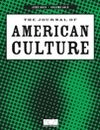
JOURNAL OF AMERICAN CULTURE
Unraveling the Threads of American NarrativesJOURNAL OF AMERICAN CULTURE is a distinguished academic journal published by Wiley, focusing on the rich tapestry of American culture through various lenses including history, literature, visual arts, and cultural studies. Established in 1996 and continuing its scholarly contributions through 2024, the journal serves as a vital platform for researchers, professionals, and students to disseminate their work and engage with critical discussions surrounding American cultural narratives. With an impressive impact reflected in its 2023 quartile rankings — Q2 in Literature and Literary Theory and Q3 in Cultural Studies, History, and Visual Arts and Performing Arts — the journal enhances scholarly dialogue across diverse disciplines. Although it does not offer Open Access options, its rigorous peer-review process ensures high-quality research dissemination. It is a go-to resource for those aiming to explore the evolving dynamics of American culture within a global context.
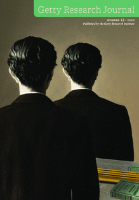
Getty Research Journal
Transforming Ideas into Impact in the ArtsGetty Research Journal, published by University of Chicago Press, is an influential periodical in the fields of Conservation, History, Museology, and Visual Arts and Performing Arts. Established in the United States, this journal aims to foster scholarly discourse and advance research in the visual arts and cultural heritage, making it a vital resource for researchers, professionals, and students alike. While it holds a Q4 ranking across multiple disciplines in the 2023 category quartiles, indicating opportunities for growth and engagement, its unique focus on the interplay between art, history, and conservation provides a distinct platform for innovative ideas. The journal encompasses a diverse range of topics, encouraging interdisciplinary research that underscores the importance of the arts in society. As it converges years from 2015 to 2024, the Getty Research Journal serves not just as a publication, but as a dynamic forum for critical thought and exploration in the expansive realm of art and culture.

SituArte
Connecting Global Trends with Local NarrativesSituArte is an esteemed academic journal published by UNIV ZULIA-VENEZUELA, focusing on the interdisciplinary fields of art, culture, and social sciences, particularly within the Latin American context. With its ISSN 1856-7134 and E-ISSN 2542-3231, SituArte endeavors to foster critical discourse and promote innovative research that explores the dynamic interplay between visual culture and societal impacts. Although this journal does not currently offer open access options, it remains a vital resource for researchers, professionals, and students seeking to contribute to the evolving conversations in these disciplines. Situated in Maracaibo, Venezuela, SituArte emphasizes regional perspectives while engaging with global trends, making it an essential platform for disseminating scholarly work that challenges conventional paradigms and enriches the academic community.
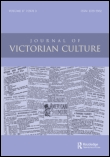
Journal of Victorian Culture
Decoding the Victorian Influence on Modern SocietyThe Journal of Victorian Culture, published by Oxford University Press, is an esteemed academic journal that explores the multifaceted cultural landscape of the Victorian era. With a publication history spanning from 1996 to 2024, this journal serves as a critical platform for scholars and practitioners in the fields of Cultural Studies, History, Literature and Literary Theory, and Visual Arts and Performing Arts. It currently holds notable rankings, including Q3 in Cultural Studies and History, and Q2 in Literature, making it a prominent resource in these disciplines. Targeted at an audience that includes dedicated researchers, professionals, and students, the journal promotes interdisciplinary exploration and innovation, encouraging contributors to engage deeply with Victorian themes and their influence on contemporary culture. For those interested in cutting-edge discussions and insights, the Journal of Victorian Culture provides access to rich, scholarly content that is indispensable for understanding the era's impact on modern artistic and social paradigms.
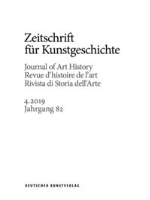
ZEITSCHRIFT FUR KUNSTGESCHICHTE
Fostering Insightful Discussions on Art and CultureZEITSCHRIFT FUR KUNSTGESCHICHTE is a prestigious journal dedicated to the study of art history, offering insightful analyses and discussions that enrich the understanding of visual arts and performing arts. Published by DEUTSCHER KUNSTVERLAG GMBH in Germany, this journal has established itself as a significant platform for researchers and professionals alike since its inception. With a print ISSN of 0044-2992 and an e-ISSN of 2569-1619, it spans a comprehensive range of topics in art history, reflecting both traditional and contemporary perspectives. Although categorized in the Q4 quartile for Visual Arts and Performing Arts, the journal contributes to a rich dialogue within its field, aiming to foster academic discourse and promote scholarly research. Its scope has evolved notably from converged years starting in 1975 and gathering strength from 2001 to 2024, and it is committed to serving as an essential resource for students, academics, and practitioners in the arts. While not offering open access, the journal maintains a rigorous peer-review process to ensure high-quality submissions that advance knowledge and stimulate critical thought.

EIGHTEENTH-CENTURY LIFE
Bridging Disciplines to Understand a Transformative EraEIGHTEENTH-CENTURY LIFE is a prominent academic journal published by DUKE UNIVERSITY PRESS, focusing on the interdisciplinary study of the 18th century through the lenses of Cultural Studies, History, Literature, and the Visual Arts and Performing Arts. With an established history since 1977, this journal serves as a vital platform for scholars and students to publish innovative research and critical discourse, shedding light on the complex social, political, and artistic currents of the 18th century. Despite its current ranking in the lower quartiles according to Scopus, the journal continues to foster scholarly dialogue and contribute to the understanding of this pivotal era in Western history. Its accessible yet scholarly articles make it a valuable resource for researchers, educators, and students alike, facilitating engagement with 18th-century studies from various disciplinary perspectives.

Visual Studies
Illuminating the dialogue between art and society.Visual Studies, published by Taylor & Francis Ltd, is a leading international journal that serves as a vital platform for interdisciplinary scholarship in the fields of visual arts, cultural studies, and anthropology. Established in 2002 and continuing strong through 2024, it holds impressive rankings including Q1 in Cultural Studies and Visual Arts and Performing Arts, as well as Q2 in Anthropology, reflecting its significant impact and prestige within these disciplines. With a robust Scopus ranking placing it in the 89th percentile for Visual Arts and Performing Arts, this journal does not only publish original research but also fosters rich dialogues on visual culture, representation, and critical theory. Although it is not open access, researchers, practitioners, and students alike can benefit from its rigorous peer-reviewed content, which contributes to advancing knowledge and understanding of visual phenomena. Located in the United Kingdom, Visual Studies continues to shape the conversations surrounding visual practices and their societal implications.
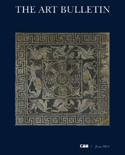
ART BULLETIN
Fostering Innovative Perspectives on Artistic ExpressionART BULLETIN is a prestigious journal dedicated to the fields of history and visual arts, published by Routledge Journals, Taylor & Francis Ltd. With a rich publication history dating back to 1945, this journal serves as a vital platform for scholarly discourse, presenting cutting-edge research and critical analyses that contribute to our understanding of the arts across various contexts. Despite its Q3 ranking in both the History and Visual Arts categories, the journal has managed to achieve notable stature among its peers, evidenced by its Scopus ranking, placing it in the top 20% for Visual Arts and in the top 25% for History. Scholars and students alike will find valuable insights and innovative perspectives within its pages, making it an essential resource for anyone invested in the academic exploration of art and cultural history. Although currently not open access, the journal is committed to fostering an informed community by disseminating works that encourage scholarly engagement and creative thought.

European Journal of Media Art and Photography
Exploring the Intersection of Art and Media.The European Journal of Media Art and Photography (ISSN: 1339-4940), published by UNIV SS CYRIL & METHODIUS TRNAVA, serves as a vital platform for innovative scholarship in the intersection of media, art, and photography. With a focus on contemporary practices and theoretical explorations, this journal aims to advance discourse within these dynamic fields, attracting researchers, practitioners, and students alike. By providing a forum for original research papers, critical essays, and groundbreaking projects, it promotes the exchange of ideas that can influence future trends in art and visual culture. Although specific metrics such as impact factor and H-index are not available, the journal is committed to upholding rigorous academic standards and fostering accessibility in research while encouraging submissions that push the boundaries of traditional media and artistic expression. Located in Slovakia, the journal invites engaging contributions that critically examine the role of media in shaping visual narratives today.